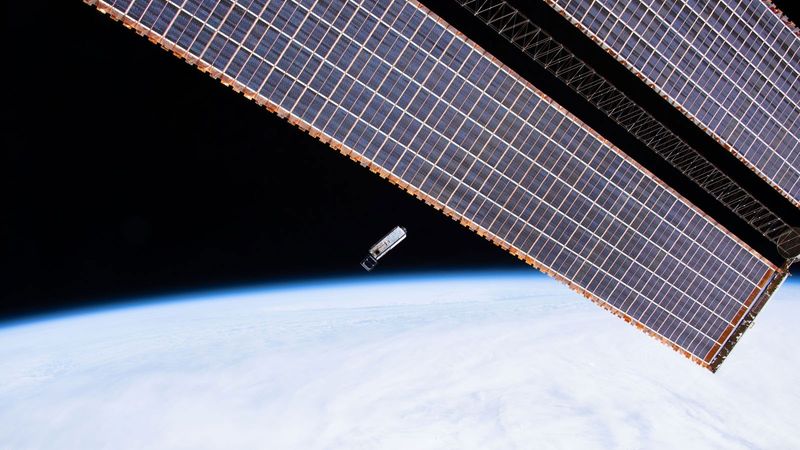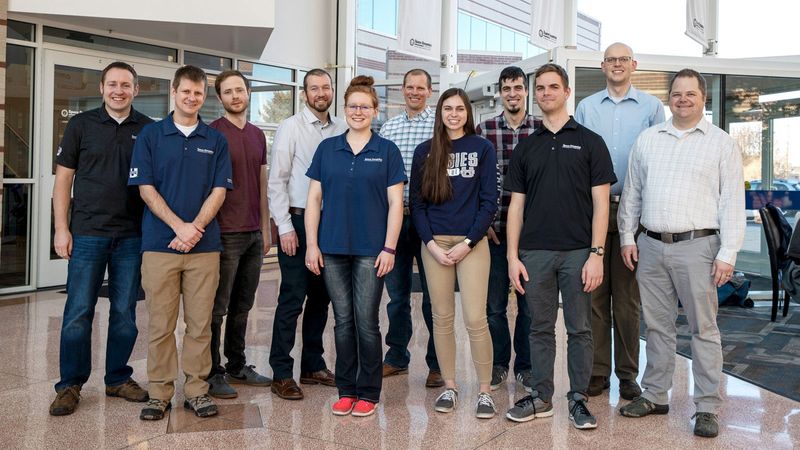
The Hyper-Angular Rainbow Polarimeter small satellite is shown in this February 19, 2020, photo shortly after it was deployed into orbit from the International Space Station. Manufactured by the Space Dynamics Laboratory to carry the payload built by the Earth and Space Institute at the University of Maryland, Baltimore County, the HARP satellite was honored with the Small Satellite Mission of the Year award today. (Credit: NASA)
The Space Dynamics Laboratory-built Hyper-Angular Rainbow Polarimeter satellite has been awarded the Small Satellite Mission of the Year award by the American Institute of Aeronautics and Astronautics. The announcement was made during the annual Small Satellite Conference.
Utah State University’s SDL designed and manufactured the HARP spacecraft to carry the University of Maryland, Baltimore County Earth and Space Institute-built HARP payload, which was developed to measure the microphysical properties of cloud and aerosol particles in Earth’s atmosphere.
The Small Satellite Mission of the Year award is presented annually by the AIAA Small Satellite Technical Committee to the mission that has demonstrated a significant improvement in the capability of small satellites. Missions must have individual satellite wet mass of less than 150 kilograms and must have launched, established communication and have acquired results from orbit after January 1, 2019, 12 a.m. Greenwich Mean Time.
“HARP has been a truly collaborative effort between UMBC and SDL, demonstrating how university organizations can collaborate with NASA to advance space science and technology to achieve major earth science goals,” said principle investigator J. Vanderlei Martins of UMBC. “The Small Satellite Mission of the Year award is a major honor to the HARP team, and a testament to the success of this collaboration.”
To demonstrate significant improvement, nominated missions must show innovation in spacecraft structural design, scientific instrument development, communications capability, attitude determination and control capability, intersatellite coordination, constellation or cluster management, onboard computing or other mission aspects.
“To be selected from the many accomplished small satellite missions throughout this year is an honor and reflects the vision, unshakeable commitment, and scientific expertise of Dr. Martins and his team at UMBC and NASA,” said Alan Thurgood, SDL’s director of Civil and Commercial Space. “The men and women of SDL share in Dr. Martins’ vision for HARP, and we are fortunate to have been able to provide the spacecraft and operational management to help enable mission success.”
The HARP mission seeks to mitigate barriers to assessing climate change that are caused by the scarcity of measurable data about aerosol forcing, insufficient understanding of aerosol-cloud processes and cloud feedbacks in the climate system. New observations and a better understanding of aerosol-cloud processes will help to narrow climate change estimate uncertainties.
“It has been a privilege for SDL to build and operate a spacecraft that is helping to validate new technology, prove the on-flight capabilities of a highly accurate, wide field-of-view hyper-angle imaging polarimeter and demonstrate that small satellites can provide top-quality Earth sciences data,” said Tim Neilsen, SDL program manager for HARP. “The engineers, technicians, spacecraft operators and other professionals at SDL remain resolute in helping to ensure HARP meets its mission objectives.”
SDL has been solving the technical challenges faced by the military, science community and industry for six decades and supports NASA’s vision to reveal the unknown for the benefit of humankind. As one of 14 University Affiliated Research Centers, SDL serves as a subject matter expert in its core research areas to the U.S. Government, ensuring that essential engineering and technology capabilities are maintained. SDL is a research laboratory headquartered in North Logan, UT, and has offices in Albuquerque, NM; Bedford, MA; Dayton, OH; Huntsville, AL; Houston, TX; Los Angeles, CA; Stafford, VA; and Washington, D.C. For more information, visit www.spacedynamics.org.

Contact
- SDL Public Relations
- 435-713-3054
- pr@sdl.usu.edu